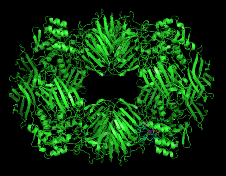Directed Evolution of a β-Galactosidase into a Transgalactosidase
SUPERVISOR: DIETMAR HALTRICH
Project assigned to: BARBARA GEIGER
Background.
β-Galactosidases catalyze both the hydrolysis and transgalactosylation of &beta-D-galactopyranosides (such as lactose). By intermolecular transgalactosylation of lactose, di-, tri-, tetrasaccharides and eventually higher oligosaccharides are produced. The products of transglycosylation, galacto-oligosaccharides (GOS) are also substrates for hydrolysis.
Galacto-oligosaccharides are nondigestible carbohydrates, so-called prebiotics, which have a positive impact on the intestinal microflora, such as reduction of adherence of the enteropathogen E. coli to the intestinal mucosa and assisting growth of beneficial bacteria. Some of them are components of human breast milk as well and as such are of great interest for infant milk formula and are among the top commercially produced prebiotics.
β-Galactosidases are abundant in animals, plants and numerous microorganisms including bacteria, fungi, archaea and yeast. Lactobacillus bulgaricus β-galactosidase was shown to have an optimal activity over a wide temperature range and at low pH values. These characteristics as well as its high stability make it an ideal target for applications in food industry. Furthermore, L. bulgaricus β-galactosidase is of interest for mutagenesis to improve its properties, in particular to enhance its transferase activity while reducing its hydrolytic activity, thereby creating a transglycosidase utilizing cheap and easily available substrates such as lactose.

Aims and methods.
The major challenge for processes using β-galactosidases for GOS production is to find conditions that will drive the reaction into the desired direction without allowing significant enzymatic degradation of the reaction products. An alternative is to modify the enzyme by semi-rational design or directed evolution to reduce the hydrolytic activity. A perfect transglycosidase will transfer the sugar from the enzyme-sugar intermediate exclusively onto a carbohydrate acceptor and not onto water. It is the aim of this project to use various methods of enzyme engineering to enhance the transglycosidase activity of L. bulgaricus β-galactosidase. The most important precondition for a successful directed evolution experiment is the availability of a fast and reliable high-throughput screening method. So far only very few systems for high-throughput screening of transglycosidases have been developed. Screening of mutant β-galactosidases for improved transfer activity is extremely challenging, because no obvious change in fluorescence or absorbance is associated with bond formation.
In vivo selection methods like FACS enable screening of large enzyme libraries at higher throughput than methods based on in vitro catalytic selection. The desired enzyme activity, however, needs to be linked to fluorescence and the coupling of genotype and phenotype is essential. Here, the main challenge is the design of a fluorogenic substrate that can penetrate the cell wall but is unable to leave the cell after the enzyme catalyzed the transferase reaction. Novel screening methods based on FACS and fluorescent-labelled substrates will be used in this project to identify suitable variants. These will then be characterised both from a biochemical and a structural point of view.
Directed evolution in combination with an ultrahigh-throughput screening could lead to identification of new important amino acid positions in and around the active center as well as unpredictable, more distant positions connected to hydrolysis and transglycosylation. Overall, the project will contribute to the structure-function relationship of β-galactosidases and related enzymes.
Feng, H. Y., Drone, J., Hoffmann, L., Tran, V., Tellier, C., Rabiller, C., Dion, M. (2005). Converting a β-glycosidase into a β-transglycosidase by directed evolution. Journal of Biological Chemistry 280, 37088-37097.
Kittl, R. & Withers, S. G. (2010). New approaches to enzymatic glycoside synthesis through directed evolution. Carbohydrate Research 345, 1272-1279.
Nguyen, T.T., Nguyen, H. A., Arreola, S. L., Mlynek, G., Djinovic-Carugo, K., Mathiesen, G., Nguyen, T. H., Haltrich, D. (2012). Homodimeric β-galactosidase from Lactobacillus delbrueckii subsp bulgaricus DSM 20081: Expression in Lactobacillus plantarum and biochemical characterization. Journal of Agricultural and Food Chemistry 60, 1713-1721.
Placier, G., Watzlawick, H., Rabiller, C., Mattes, R. (2009). Evolved β-galactosidases from Geobacillus stearothermophilus with improved transgalactosylation yield for galacto-oligosaccharide production. Applied and Environmental Microbiology 75, 6312-6321.
